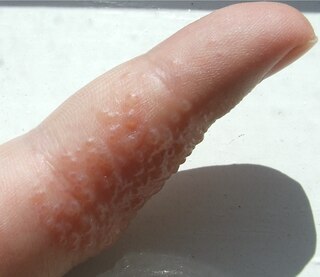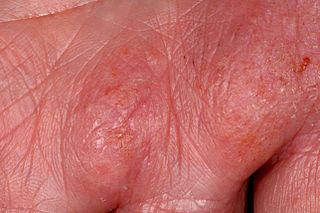
Dermatitis is inflammation of the skin, typically characterized by itchiness, redness and a rash. In cases of short duration, there may be small blisters, while in long-term cases the skin may become thickened. The area of skin involved can vary from small to covering the entire body. Dermatitis is often called eczema, and the difference between those terms is not standardized.

Lanolin, also called wool fat, wool yolk, wool wax, or wool grease, is a wax secreted by the sebaceous glands of wool-bearing animals. Lanolin used by humans comes from domestic sheep breeds that are raised specifically for their wool. Historically, many pharmacopoeias have referred to lanolin as wool fat ; however, as lanolin lacks glycerides, it is not a true fat. Lanolin primarily consists of sterol esters instead. Lanolin's waterproofing property aids sheep in shedding water from their coats. Certain breeds of sheep produce large amounts of lanolin.

Dihydroxyacetone, also known as glycerone, is a simple saccharide with formula C
3H
6O
3.

Contact dermatitis is a type of acute or chronic inflammation of the skin caused by exposure to chemical or physical agents. Symptoms of contact dermatitis can include itchy or dry skin, a red rash, bumps, blisters, or swelling. These rashes are not contagious or life-threatening, but can be very uncomfortable.
The term cleanser refers to a product that cleans or removes dirt or other substances. A cleanser could be a detergent, and there are many types of cleansers that are produced with a specific objective or focus. For instance, a degreaser or carburetor cleanser used in automotive mechanics for cleaning certain engine and car parts.

A moisturizer, or emollient, is a cosmetic preparation used for protecting, moisturizing, and lubricating the skin. These functions are normally performed by sebum produced by healthy skin. The word "emollient" is derived from the Latin verb mollire, to soften.

Dyshidrosis is a type of dermatitis that is characterized by itchy blisters on the palms of the hands and bottoms of the feet. Blisters are generally one to two millimeters in size and heal over three weeks. However, they often recur. Redness is not usually present. Repeated attacks may result in fissures and skin thickening.

Ichthammol or ammonium bituminosulfonate is a medication derived from sulfur-rich oil shale. It is used as a treatment for different skin diseases, including eczema and psoriasis. It is applied on the skin as an ointments, most commonly containing 10% or 20% ichthammol.

Atopic dermatitis (AD), also known as atopic eczema, is a long-term type of inflammation of the skin (dermatitis). It results in itchy, red, swollen, and cracked skin. Clear fluid may come from the affected areas, which can thicken over time. AD may also simply be called eczema, a term that generally refers to a larger group of skin conditions.
Natural skin care uses topical creams and lotions made of ingredients available in nature. Much of the recent literature reviews plant-derived ingredients, which may include herbs, roots, flowers and essential oils, but natural substances in skin care products include animal-derived products such as beeswax, and minerals. These substances may be combined with various carrier agents, preservatives, surfactants, humectants and emulsifiers.

In cosmetology, exfoliation is the removal of the surface skin cells and built-up dirt from the skin's surface. The term comes from the Latin word exfoliare. This is a regular practice within the cosmetic industry, both for its outcome of promoting skin regeneration as well as providing a deep cleanse of the skin barrier. Being used in facials, this process can be achieved by mechanical or chemical means, such as microdermabrasion or chemical peels. Exfoliants are advertised as treatments that enhance beauty and promote a youthful and healthy appearance.
Skin care or skincare is a range of practices that support skin integrity, enhance its appearance, and relieve skin conditions. They can include nutrition, avoidance of excessive sun exposure, and appropriate use of emollients. Practices that enhance appearance include the use of cosmetics, botulinum, exfoliation, fillers, laser resurfacing, microdermabrasion, peels, retinol therapy, and ultrasonic skin treatment. Skin care is a routine daily procedure in many settings, such as skin that is either too dry or too moist, and prevention of dermatitis and prevention of skin injuries.

Lysol is a brand of American cleaning and disinfecting products distributed by Reckitt, which markets the similar Dettol or Sagrotan in other markets. The line includes liquid solutions for hard and soft surfaces, air treatment, and hand washing. The active ingredient in many Lysol products is benzalkonium chloride, but the active ingredient in the Lysol "Power and Free" line is hydrogen peroxide. Lysol has been used since its invention in the late 19th century as a household and industrial cleaning agent, and previously as a medical disinfectant.

Hand eczema presents on the palms and soles, and may sometimes be difficult or impossible to differentiate from atopic dermatitis, allergic contact dermatitis, and psoriasis, which also commonly involve the hands. Even a biopsy of all these conditions may not result in a definitive diagnosis, as all three conditions may demonstrate spongiosis and crusting on the hands.

A pimple or zit is a kind of comedo that results from excess sebum and dead skin cells getting trapped in the pores of the skin. In its aggravated state, it may evolve into a pustule or papule. Pimples can be treated by acne medications, antibiotics, and anti-inflammatories prescribed by a physician, or various over the counter remedies purchased at a pharmacy.
Senile pruritus is one of the most common conditions in the elderly or people over 65 years of age with an emerging itch that may be accompanied with changes in temperature and textural characteristics. In the elderly, xerosis, is the most common cause for an itch due to the degradation of the skin barrier over time. However, the cause of senile pruritus is not clearly known. Diagnosis is based on an elimination criteria during a full body examination that can be done by either a dermatologist or non-dermatologist physician.
The Baumann Skin Types system is a skin-type classification system defining 16 skin personalities. This classification system was developed in 2004 by University of Miami dermatology professor Leslie Baumann, to subdivide research participants into specific phenotypes. She assigns binary values to four characteristics, so defining sixteen "skin personalities", or "skin types". These have been used in genetic research aimed at identifying the genes that contribute to skin characteristics such as dryness, oiliness, aging, pigmentation, and sensitivity. The a survey-based typing system combines these individual skin attributes into 16 personalities that allow researchers to improve their ability to identify various skin phenotypes and use that knowledge for patient selection for clinical research trials and to recommend proper skincare ingredients and products. The classification system has been adopted by estheticians, dermatologists, consumers and retailers to match cosmeceutical ingredients and skin care products to specific skin types. The type assigned is determined by a self-completed questionnaire, marketed as the "Baumann Skin Type Indicator" (BSTI).
Sodium hypochlorite washes are skin cleansers formulated with sodium hypochlorite (NaOCl) and surfactants. These cleansing liquids or gels are lathered onto wet skin and rinsed off. They are recommended for inflammatory skin conditions, microbial driven skin disorders and body odor.
Dr. Jart+ is a South Korean skin care brand. It was founded in 2004 by Lee Jin-Wook, with consultation from dermatologist Jung Sung-jae.












